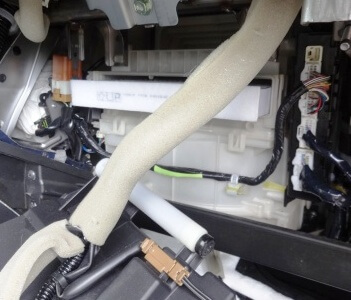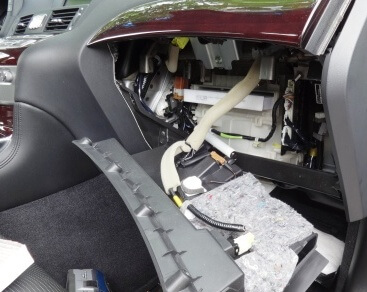Replacing Nissan Cabin Filters
Replacing Nissan cabin filters is within the skill level of most do-it-yourself minded individuals. If you price this maintenance operation at the local dealership you'll find a part and labor price tag in the $100 range.
The average cost of a premium aftermarket cabin filter falls in the $12-$15 range. Therefore, seeing if you're comfortable with performing the maintenance yourself seems worthwhile.
In this brief article we'll talk about when to replace the cabin filter and symptoms associated with a clogged filter.
In addition, we'll provide a video right here: How to Replace the Cabin Filter on Nissan Cars.
Keep in mind that the procedure outlined in the video and in the article below covers both Nissan and Infiniti automobiles with the filter located behind the glove box.
Many automotive consumers don't realize that the Infiniti Q50 Red Sport and G series remain nothing more than a fancy Nissan Maxima and Nissan Altima respectively.
In adition, the Nissan Murano lurks below the sleek body panels of the Infiniti FX35 for that matter.
 Replacing Nissan Cabin Filters
Replacing Nissan Cabin FiltersEven though some other differences exist between the Infiniti and Nissan models mentioned, the heating and air conditioner case that holds the interior filter element are the same.
Here's another interesting fact. Many of the SUV and crossover vehicles also share the same heat and AC housing.
With that said, always check the compatibility chart before ordering these pollen filters over the internet.
Finally, in the final thoughts section we'll talk about running the air-conditioning without an air filter.
In fact, we’ll actually explain what happens if you throw this part in the trash when it gets clogged. Hint, improving the interior air quality isn’t the only job of this automotive maintenance item.
When to Replace the Cabin Filter
Some people call this part a pollen filter. This is a good name for it, because when you pull it out that's mostly what you find in the pleated material.
Heavier particles such as sand and dirt are less likely to make it all the way up to the air intake inlet area. A lot of people want to know when to replace the cabin filter.
It's hard to apply set in stone standards for this automotive maintenance problem. In fact, I would say replace it as needed.
The manufacturer on the other hand recommends replacing it every 30,000 miles. Nevertheless, the operating conditions the vehicle experiences play a big role in how soon the filter clogs.
With that said, there are telltale signs that you have waited too long and it's time to go ahead and replace the part.
The most obvious condition becomes a reduction of airflow from the vents with maximum blower selected. The pollen filter can become so clogged that it starts to restrict the air flow.
Sometimes before replacing Nissan cabin filters people hear a whistling sound. Any noises such as a ticking, rattling or whistling noise should send you right to the cabin filter for an inspection.
Since there's a little work with replacing Nissan cabin filters it's nice to have one on the shelf or ready to go in this situation.
Replacing Nissan and Infiniti Cabin Filters
 Cabin Filter Replacement Diagram
Cabin Filter Replacement DiagramObviously, we provide a picture that's worth 1000 words in this article and in the video below. Replacing the pollen filter looks more daunting than it actually is.
In fact, you can get away with only using one tool for the entire operation. A number two Phillips screwdriver is required to remove the seven screws from the panel that covers the heater case.
Another item worth mentioning is the removal of the glove box. When you look at all of the videos that show you how to replace Nissan cabin filters each use a different method.
Some like to keep the box mounted to the plastic panel and remove it as one assembly when replacing Nissan cabin filters.
I have no problem with this, but you will need an extra long Phillips screwdriver. If you decide to take the glove box off as I do in the video, bear in mind that, with the glove compartment open it simply snaps into place.
Replacing Nissan Cabin Filters Final Thoughts
My final thoughts about replacing a pollen or cabin filter element. There are a lot of different replacement air filters available. Some talk about activated carbon or HEPA filtration.
Let's dig into this a little further before you make your decision on which one to buy. As far as I can tell after reading several articles about carbon activated filters we use to call these charcoal filters.
The filters claim to reduce odors in the air that passes through them. It seems like a good idea, but I'm not sure how effective it is.
After discussing the results with a customer, she said, they only noticed a difference in air quality for a few weeks.
The next cabin filter to talk about is the ones with HEPA filtration technology. I like the idea of this, because it filters out more of the nasty pollen and things that you don't want inside your car.
The downside is that because it pulls more particles from the air, it clogs faster. In the end a cabin filter not only protects the passengers from irritating allergens, it also protects the evaporator from clogging with debris.
On old car air-conditioning systems prior to the invention of pollen filters, we would have to clean and service the evaporator coil every 60,000 miles.
The heat exchanging aluminum fins use to get clogged with hair and dirt to the point where the AC wouldn't cool any more.
They even made a special tool to perform the evaporator cleaning operation. For this reason the main take away from this entire article is to always replace the cabin filter and don't try to run the system without it. You don't want to remove the evaporator core on cars.
Author bio : Mark is a retired ASE certified master technician, Chevrolet Professional Service Council member and the founder of FixMyOldRide.com. Watch the video on the about Mark the mechanic page to see his credentials. Mark hand writes all of the articles on FixMyOldRide.com unless indicated otherwise.